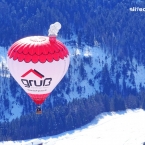
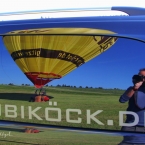

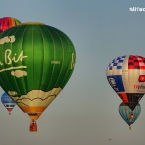
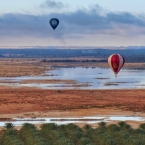
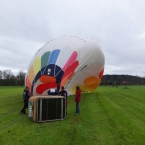
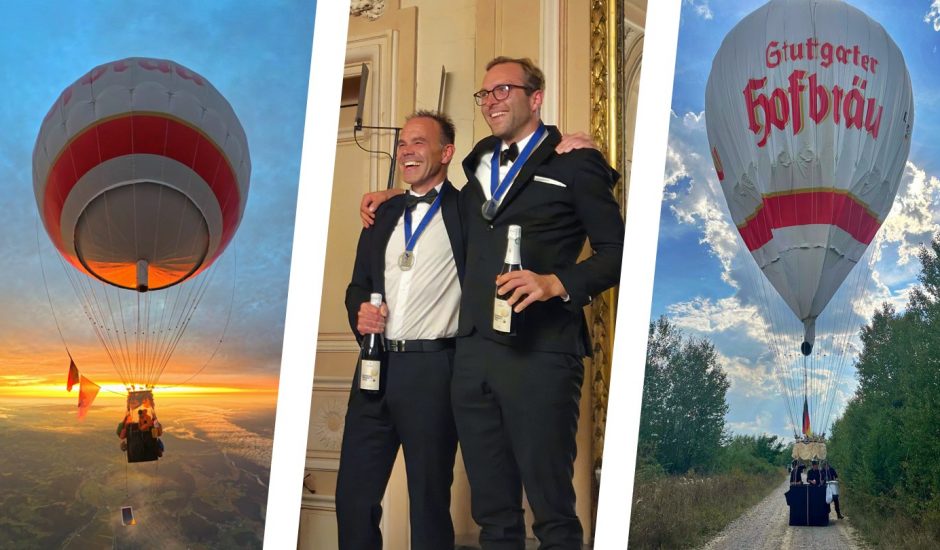
Silver medal for team Germany-3 at the world’s oldest aviation race
Benedict Munz and Matthias Schlegel become Vice World Champions at the 68th Coupe Aéronautique Gordon Bennett 2025
Participating in the legendary Gordon Bennett Race is an absolute dream for every balloonist. The traditional competition – the oldest and most prestigious air sports event in the world still held – demands everything from the pilots: stamina, tactical skill, and the ability to make the most of every weather situation. Benedict and Matthias, for whom it was a very special moment to compete with the German national team for the 6th time, take us with them on their journey.
Extensive preparations: A self-built balloon basket
Camping in the sky, in just 1.2 square meters: This image succinctly describes what we do up there for several days. Such an adventure requires a lot of preparation and planning – and our road to the Gordon Bennett 2025 was even more special. After more than six years of unsuccessfully search for a lighter gas balloon sports basket, we finally decided to take things in our own hands and build one ourselves.
After weeks and weeks of CAD construction at the computer and countless hours in the workshop, we were ready for the EASA certification program in early January. Together with EASA employee Stefan, we conducted all the drop and load tests required in the balloon depot of the Stuttgart balloon club. The result: around 75 kilograms of weight savings and a competition basket tailored precisely to our needs – bedroom, balcony, kitchen, toilet, all in one. The first major success of this project we were even able to celebrate before the Gordon Bennett Race: the nomination for the Hellmut-Niethammer-Foundation Innovation Award!
Not only the basket, but also the rest of our equipment had to be a lot lighter: All items on our packing list, over 100 in number, from batteries to toothbrushes, had to be weighed and critically examined: Do we really need this? Is there a more lightweight alternative? We saved another 35 kilograms this way. Benedict took it one step further with an ascetic diet, losing almost 20 kilograms from January to September 2025.
Thus optimized, we set off at 6 a.m. on Thursday, September 4th, for Metz, this year’s host city of the Gordon Bennett Race, to begin the final preparations on site: filling sandbags at the old airfield of Metz-Frescaty, shopping, coordination with our Command Center, general briefing, and the opening ceremony at the futuristic Centre Pompidou.
Key to success: The Command Center
With the long competitive gas balloon flights across countries and oceans and the enormously increased performance of the teams in the recent years, support from the ground has become indispensable. Thanks to mobile internet, the complex navigation with constantly changing wind and weather patterns is manageable for the two pilots in the basket – but it’s difficult to be successful as a lone fighter in the skies.
For several years now, the three gas balloon pilot couples of the German National Team have had a shared Command Center, consisting of five to ten people who continuously look after us and provide us with the necessary information. Their responsibilities include weather and strategy, of course, but also airspaces, air traffic control, restricted areas, and so on. Having said that, a very big thank you to our Command Center 2025, Max & Max, Marvin, Katharina, Mathis, Henrike, Ivan, and Andreas.
Ground Logistics: The Retrieve
In addition to the Command Center, the retrieve is another important part of our crew. While we travel several hundred, if not thousands, kilometers in the air, we also have to get home somehow. Thanks to our large club, we were able to motivate our members Peter and Finn, in addition to partially staffing the Command Center, to embark on this road trip with an unknown destination. Unfortunately, Finn was unable to make it due to illness at short notice, which is why only the three of us were able to travel to Metz initially. But a replacement was quickly found: Peter passed by Stuttgart on the way back and picked up Timo, who stood in for his sick friend. Thank you so much guys, without you, this trip and this success would not have been possible.
Finally there
Weather was looking good for the Gordon Bennett weekend, and so, it was clear that the scheduled launch date, Friday evening, September 5th, would work out. The receding cold front brought us some wind and a few showers in the surroundings during the day, but this subsided over the afternoon and only slightly delayed the balloon rigging and launch. Thanks to a perfect preparation, filling the balloon went very smoothly for us, and our D-OSTL “Stuttgarter Hofbräu” was ready to go long before the scheduled launch. Time enough for us pilots to take a leisurely stroll around the launch field and wish the other competitors a pleasant and safe flight, while some of them were still making final preparations in their baskets.
At 10:59 p.m., we are finally standing on the podium as the 18th out of 24 teams. A farewell kiss for our girls, handshakes with family, friends, and supporters, the national anthem rings out, and we follow the full moon into the night sky above Lorraine.
First Night Tactics
The trajectories we had calculated in advance were truly exciting this year: While the winds in the lower levels were blowing towards the North Sea and Scandinavia, balloons would head southeast at altitude, over Germany, Austria, and Slovenia, to the Balkans or the Black Sea. Although we had been looking forward to a flight to Scandinavia for years, it quickly became clear that the northern route would involve significantly more risk and worse weather. Likewise, the distances achievable in the south seemed greater – the North Cape is significantly farther from Metz than Greece, but if you can’t find wind currents that will take you there, it is not a profitable strategy.
So our plan for the first night is to head east, as ballast saving as possible. Only if things get too slow or the direction deviates significantly from our target, we sacrifice some shovels of sand to climb higher and stay on track. As the sun rises, our balloon is gently warmed and climbs a few hundred meters further, where its direction and speed stabilize.
From Metz to Munich
From Saturday morning on, our Command Center is regularly calling the Munich air traffic controllers to pave our way through the busy Munich airspace, which we should be reaching around 9 p.m. Meanwhile, we climb to around 4,000 meters to fly as southerly as possible and only touch the outskirts of said airspace. On other hands, the first day is quite relaxed: with perfect weather and a panoramic view of the Alps, we enjoy the familiar landscape below us, sparking many memories of past events – Horb with the Neckar Balloon Cup and British Nationals 2023 for example, or the Übersberg glider airfield with its many unforgettable editions of the BWLV Youth Airgames.
South of Augsburg, the moon finally rises and the sun sets – we can’t quite enjoy the scenery yet, because our entry into Munich airspace is still not guaranteed. A little later, however, the relieving radio message follows: crossing approved between FL120 and FL140. The excellent preparatory work of our Command Center has once again opened a door. South of Lake Chiemsee, we reach the first peaks of the Bavarian Alps.
Night over the Alps
It is a major highlight for many balloonists to cross the Alps… and we do it just like that. Alas, we don’t get much of a chance to enjoy it, as it is dark, and our oxygen regulators are giving us a headache. The portable puls-demand systems are supposed to deliver a shot of oxygen to our cannulas every time we inhale, but the shallower breathing we take while sleeping constantly causes the alarm to go off, trying to prevent us from suffocating – not a particularly relaxing state. None of us get a good night’s sleep.
Only a few hours later, when we test our replacement regulator, we discover that this slightly older model is better at handling shallow breathing. From then on, we don’t have to endure further beeping and sleep a lot better. Perhaps we are simply tired enough by now.
Sunday over Croatia
At sunrise on Sunday, we leave the Alps near Klagenfurt. Our retrieve send a picture from Lake Wörthersee. Our balloon’s position is slightly further west than calculated by our Command Center, but still within our strategy. With the new weather model run, it becomes clear that reaching Bulgaria during the day is no longer possible. Some race-specific restrictions make it even more tactical in the southern Balkans: Kosovo was unable to grant general entry permission for the balloons, which is why it is closed to all Gordon Bennett participants; the same applies to VFR night in Bulgaria and Greece. Anyone in the air between sunset and sunrise will be given no result.
We adapt our strategy to the shifting winds and abandon the idea of ouzo after landing. Romania or Bulgaria are the options, the latter – as mentioned above – only during the day. The weather maps predict increasing instability with possible showers and thunderstorms northwest of the Carpathians; we definitely don’t want to go there. Thanks to our attempt to pass Munich’s airspace to the south, we’re still the most southwestern balloon in the race. In the group of five leaders, we pass Osijek at dusk and head for Serbia. The long, narrow street villages below us turn to glowing lines in the dark.
But spirits are high on board: We still have over 150 kilograms of ballast sand left. For the first time since participating in the Gordon Bennett Race, we feel like we can seriously compete at the front. The new lightweight basket, the radically trimmed down equipment, and, last but not least, Benedict’s diet, are paying off.
Gordon Bennett: Endgame
At dawn on Monday, the Serbian-Romanian border lies ahead of us. Besides us, only six other balloons are still in the air – already the best placement we’ve achieved in our races so far. Our ballast would probably last for another night, but we’re currently heading toward the Carpathian Mountains, and they’re not particularly attractive, neither in terms of the landing area, nor the thunderstorms forecasted there. Last but not least, they got bears there!
The Command Center sends us a map with lots of concentric circles, all centered on Metz, so we can see which direction is most profitable for us. We spot a broad valley southeast of Timisoara, which we could still reach while keeping a respectful distance to the towering cumulus clouds. Anulfo and Angel, our Spanish friends, land near Arad; Team Austria-2, last year’s winners, land a little later south of Oradea. The weather in this area is already too unstable, the clouds are rising too high.
When our air traffic controller confirms over the radio that the two restricted military areas ahead of us are inactive and nothing’s in our way of flight, the game is on: We’re in the final battle for the podium. Our most southwestern position in the leading group has paid off. Team Germany-2, also near Arad, won’t be able to go much farther. Germany-1 is still behind us in Serbia, but can’t catch up anymore. They barely have any ballast left.
While we are outperforming Benni and Nicholas from Germany-2, we are overtaken by Kurt and Pascal. The two experienced Swiss pilots have been staying in the background for quite some time and are now passing us at almost 6,000 meters to our southwest, far away from the unstable air masses – a truly world-class strategy!
On the radio, we are listening to the conversation between the team ahead of us, France-2, and the controller. They plan to land in the next few minutes and close their flight plan. Eric and Benoit are currently in second place. Text messages fly back and forth with the Command Center. The French landing is confirmed by the race headquarter. We have to fly three more kilometers to the east to beat them. And we are still exactly on track.
Ups and Downs
But the clouds have also started to grow around us. We manage to dodge one by climbing up, but the wind direction up there isn’t really helping us. With a small pull on the parachute, we drop back down below the cloud base. The wind direction there is much better. One more kilometer to go! But the thermals are playing with our balloon, pulling us back up to just below the base. Soon, we’re descending just as quickly, having to shed precious ballast. We can’t play this game forever.
The distance should be enough to be ahead of the French, our Command Center tells us – now for a safe landing! But just as luck would have it, a large forest beneath us. To the left, in the distance, a big field, to the right, a forest track with a few clearings beside it… in the thermals, the direction of flight is indefinable. First, we head toward the field, then back onto the forest path. Peter and Timo, our brave retrieve, have realized our situation and are speeding along the track. If we throw our tow rope right over the track, it might work out! The two of them stop just in time, exit the van, we brush against a few branches, the tow rope rushes through the trees… Seconds later, we’re safely down on the track.
In the last few minutes of fighting, we almost lost our bearings. How far have we come? Will it be enough for second place? After anxious seconds, the relieving message from the Command Center: WE DID IT! VICE WORLD CHAMPIONS!!!
All the tension fades away from us. We can’t quite enjoy our triumph yet; thunder rumbles in the distance – we have to pack the balloon as soon as possible! A few minutes later, the envelope is down safely on the track, and we can toast to our landing with our retrieve and some curious Romanian farmers from the village close by. What a nerve-wracking finale.
We coordinate the return trip with Benni and Nicholas from Team Germany-2 and decide to share a hotel in Szeged, Hungary, to celebrate the evening. Three German teams in 2nd, 4th, and 7th place – an incredible performance by the Command Center and the pilots!
In the car, we switch on our tablet to watch the current live broadcast of Gordon Bennett TV. Team Switzerland 1, with Kurt and Pascal, have landed safely with the last two bags of sand near Gogosu, also in Romania. Hats off to this masterpiece.
Celebrations
Well-rested, we set off on the ten-hour journey home to Stuttgart on Tuesday morning, a relatively short journey compared to last year, when we had to drive a good 2,000 kilometers back to Münster. So, after a happy return, we use Wednesday and Thursday to tidy up the equipment in our balloon depot before heading back to Metz on Friday.
Friday evening, the balloon teams’ welcome back party is taking place in a cozy atmosphere. Stories of exciting landings, tricky decisions, lucky rescues… and congratulations over and over. Even Eric and Benoit, whom we left behind by just 1.4 kilometers, are heartily congratulating us on our success. No other team has made such progress in the recent years, they both say. A well-deserved place on the podium.
The following day, Saturday evening, the awards ceremony is on in Metz’s town hall, directly across from the impressive cathedral. Of course, we are shining up like new pennies in our suits and bow ties, as befits the occasion. We proudly receive our silver medals, our instructor Tomas, a six-time Gordon Bennett participant himself and our mentor from the very beginning, being even prouder. He, too, deserves our sincere thanks.
Teamwork behind the scenes
What often goes unnoticed by spectators: A flight like this is never just the achievement of two pilots in a balloon. Our heartfelt thanks go to the members of the Stuttgart Balloon Club, especially our retrieve, the aviation associations of Baden-Württemberg and Germany (BWLV, DaeC) and our entire Command Center, who supported us throughout the flight with precise weather analysis, navigation data, and also mental support. We felt most safe at all times before, during, and after the flight, knowing we have a strong and able team behind us.
A Look Ahead
For us, this title is a major milestone – and at the same time, motivation to continue working on ourselves, our tactics, and our equipment. Like every sport, ballooning thrives on innovation, passion, and team spirit. We are delighted that our flight allows us to bring a piece of this fascination home with us – and hope to continue successfully carrying ballooning around the world in the future.
Benedict Munz & Matthias Schlegel
The passion of a lifetime: To behold the stunning beauty of our world like no one else, free like a bird, high in the sky, yet one with nature, using the oldest principle of flight known to man: Lighter than air.
No wings, no noise, no pressure… just serenity, just perfect bliss. At one with the elements… at one with yourself.
This is why we live A LIFE OF BALLOONING.
